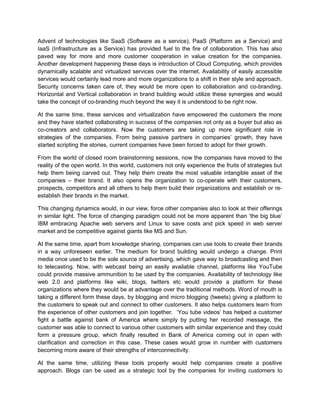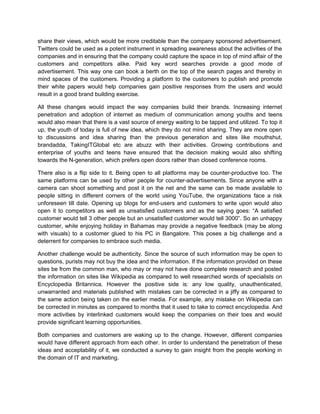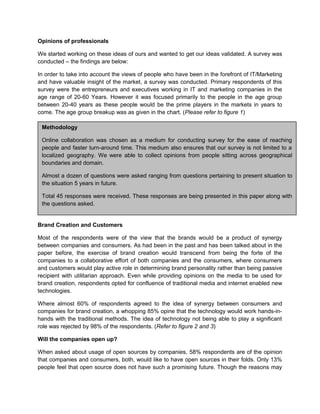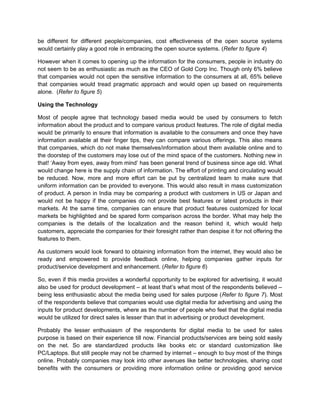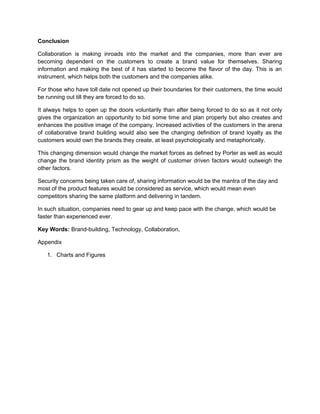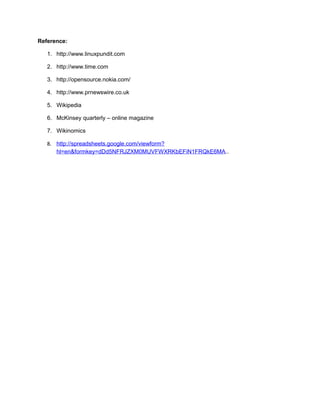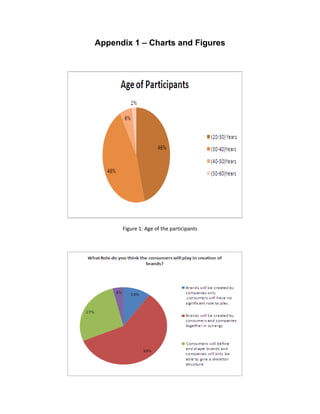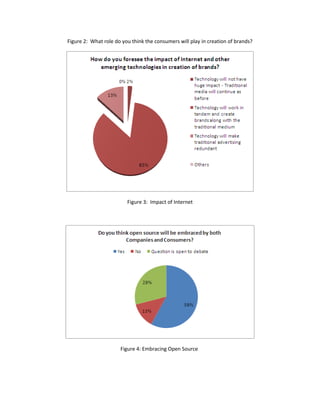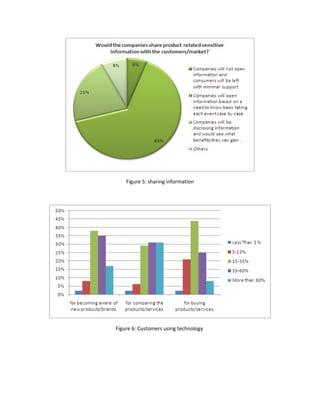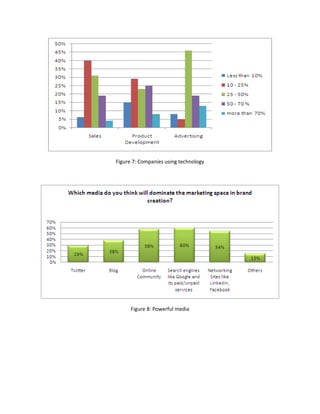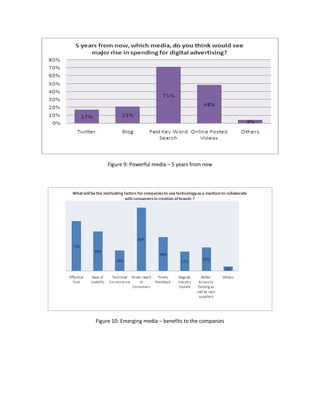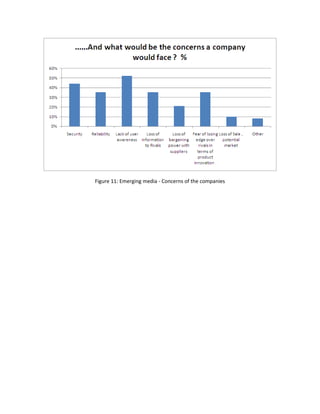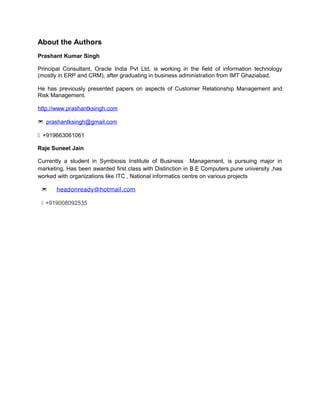Collaborative Brand Building Efforts v1.0
- 1. Collaborative Brand Building Efforts âChanging patterns and the role of technology as facilitator All these instances have one thing in common. They have emphasized on collaboration, which has worked wonders for them in brand creation. It starts with bringing in open, the brain storming sessions, which used to happen behind the closed door and till recently were safeguarded as the top most secrets. Also it reflects the changing mindsets of the organizations. For economic reasons or for the reason of getting better technical inputs beyond organizational boundaries, companies are now embracing openness in their approach of managing their brands. Instance 1: In August 1991, a student at the University of Helsinki posted a request to an Internet discussion group asking for help on a project to build a free computer operating system (OS). Linus Torvalds wanted an OS that he could tinker with. But neither Apple nor Microsoft was much interested in giving away the codes that make their machines run. With this simple request, Torvalds began a process that would complete one of the most extraordinary collaborations in history. In 1984 M.I.T. researcher Richard Stallman had launched the "free-software movement" in a project to build a free operating system that he called GNU. It provided the scaffolding within which Torvalds' kernel ("Linux") could hang. In the dozen years since Torvalds' post, literally thousands of programmers from around the world have authored and tinkered with the GNU and Linux code to produce Microsoft's most dreaded competition. Microsoft's fear is not that this GNU/Linux OS is better. It might well be, but that's a problem Microsoft could fix. Yet what Microsoft sells no one else can, because the company controls the source code that makes its programs run. The source for GNU/Linux, however, is free for anyone to take. That freedom is guaranteed by the license that governs it. And that guarantee has led key competitors of Microsoft-- IBM, in particular--to invest billions in an OS that has been promised to remain free. 1 Using methods very comparable to those for brand value calculation, IDC recently estimated that Linux-related revenues (PCs, servers, and packaged software) in 2004 accounted for US$15 billion, and will amount to over US$35 billion by 2008. FIFTEEN BILLION DOLLARS - $15,000,000,000 - that places Linux in the top 20 global brands, just ahead of Ford and Honda, and right behind BMW. Instance 23 : Nokia acknowledges the value in creating open source software in collaboration with others. A number of Nokia developers are directly involved in creating, refining, testing, using, and supporting open source software. Currently, Nokia hosts, contributes to, and/or sponsors multiple open source projects and initiatives.2 Instance 32 : Within just one week of launching its 6 million ounce online exploration challenge, Canadian gold mining company, Goldcorp, attracted the attention of the mining industry on every continent. US$500,000 in prizes and a rare opportunity to review in detail one of the worldâs richest and highest-grade gold deposits were the key attractions. Goldcorp Chairman and CEO, Rob McEwen regarded the Challenge as a LINUX inspired global brainstorming for the mining industry. The Challenge web site received more than 120,000 hits. More than 600 individuals, corporations, domestic and foreign government geological agencies and universities, representing 33 countries, registered for the Challenge
- 2. Advent of technologies like SaaS (Software as a service), PaaS (Platform as a Service) and IaaS (Infrastructure as a Service) has provided fuel to the fire of collaboration. This has also paved way for more and more customer cooperation in value creation for the companies. Another development happening these days is introduction of Cloud Computing, which provides dynamically scalable and virtualized services over the internet. Availability of easily accessible services would certainly lead more and more organizations to a shift in their style and approach. Security concerns taken care of, they would be more open to collaboration and co-branding. Horizontal and Vertical collaboration in brand building would utilize these synergies and would take the concept of co-branding much beyond the way it is understood to be right now. At the same time, these services and virtualization have empowered the customers the more and they have started collaborating in success of the companies not only as a buyer but also as co-creators and collaborators. Now the customers are taking up more significant role in strategies of the companies. From being passive partners in companiesâ growth, they have started scripting the stories, current companies have been forced to adopt for their growth. From the world of closed room brainstorming sessions, now the companies have moved to the reality of the open world. In this world, customers not only experience the fruits of strategies but help them being carved out. They help them create the most valuable intangible asset of the companies â their brand. It also opens the organization to co-operate with their customers, prospects, competitors and all others to help them build their organizations and establish or re- establish their brands in the market. This changing dynamics would, in our view, force other companies also to look at their offerings in similar light. The force of changing paradigm could not be more apparent than âthe big blueâ IBM embracing Apache web servers and Linux to save costs and pick speed in web server market and be competitive against giants like MS and Sun. At the same time, apart from knowledge sharing, companies can use tools to create their brands in a way unforeseen earlier. The medium for brand building would undergo a change. Print media once used to be the sole source of advertising, which gave way to broadcasting and then to telecasting. Now, with webcast being an easily available channel, platforms like YouTube could provide massive ammunition to be used by the companies. Availability of technology like web 2.0 and platforms like wiki, blogs, twitters etc would provide a platform for these organizations where they would be at advantage over the traditional methods. Word of mouth is taking a different form these days, by blogging and micro blogging (tweets) giving a platform to the customers to speak out and connect to other customers. It also helps customers learn from the experience of other customers and join together. âYou tube videosâ has helped a customer fight a battle against bank of America where simply by putting her recorded message, the customer was able to connect to various other customers with similar experience and they could form a pressure group, which finally resulted in Bank of America coming out in open with clarification and correction in this case. These cases would grow in number with customers becoming more aware of their strengths of interconnectivity. At the same time, utilizing these tools properly would help companies create a positive approach. Blogs can be used as a strategic tool by the companies for inviting customers to
- 3. share their views, which would be more creditable than the company sponsored advertisement. Twitters could be used as a potent instrument in spreading awareness about the activities of the companies and in ensuring that the company could capture the space in top of mind affair of the customers and competitors alike. Paid key word searches provide a good mode of advertisement. This way one can book a berth on the top of the search pages and thereby in mind spaces of the customers. Providing a platform to the customers to publish and promote their white papers would help companies gain positive responses from the users and would result in a good brand building exercise. All these changes would impact the way companies build their brands. Increasing internet penetration and adoption of internet as medium of communication among youths and teens would also mean that there is a vast source of energy waiting to be tapped and utilized. To top it up, the youth of today is full of new idea, which they do not mind sharing. They are more open to discussions and idea sharing than the previous generation and sites like mouthshut, brandadda, TakingITGlobal etc are abuzz with their activities. Growing contributions and enterprise of youths and teens have ensured that the decision making would also shifting towards the N-generation, which prefers open doors rather than closed conference rooms. There also is a flip side to it. Being open to all platforms may be counter-productive too. The same platforms can be used by other people for counter-advertisements. Since anyone with a camera can shoot something and post it on the net and the same can be made available to people sitting in different corners of the world using YouTube, the organizations face a risk unforeseen till date. Opening up blogs for end-users and customers to write upon would also open it to competitors as well as unsatisfied customers and as the saying goes: âA satisfied customer would tell 3 other people but an unsatisfied customer would tell 3000â. So an unhappy customer, while enjoying holiday in Bahamas may provide a negative feedback (may be along with visuals) to a customer glued to his PC in Bangalore. This poses a big challenge and a deterrent for companies to embrace such media. Another challenge would be authenticity. Since the source of such information may be open to questions, purists may not buy the idea and the information. If the information provided on these sites be from the common man, who may or may not have done complete research and posted the information on sites like Wikipedia as compared to well researched words of specialists on Encyclopedia Britannica. However the positive side is: any low quality, unauthenticated, unwarranted and materials published with mistakes can be corrected in a jiffy as compared to the same action being taken on the earlier media. For example, any mistake on Wikipedia can be corrected in minutes as compared to months that it used to take to correct encyclopedia. And more activities by interlinked customers would keep the companies on their toes and would provide significant learning opportunities. Both companies and customers are waking up to the change. However, different companies would have different approach from each other. In order to understand the penetration of these ideas and acceptability of it, we conducted a survey to gain insight from the people working in the domain of IT and marketing.
- 4. Opinions of professionals We started working on these ideas of ours and wanted to get our ideas validated. A survey was conducted â the findings are below: In order to take into account the views of people who have been in the forefront of IT/Marketing and have valuable insight of the market, a survey was conducted. Primary respondents of this survey were the entrepreneurs and executives working in IT and marketing companies in the age range of 20-60 Years. However it was focused primarily to the people in the age group between 20-40 years as these people would be the prime players in the markets in years to come. The age group breakup was as given in the chart. (Please refer to figure 1) Methodology Online collaboration was chosen as a medium for conducting survey for the ease of reaching people and faster turn-around time. This medium also ensures that our survey is not limited to a localized geography. We were able to collect opinions from people sitting across geographical boundaries and domain. Almost a dozen of questions were asked ranging from questions pertaining to present situation to the situation 5 years in future. Total 45 responses were received. These responses are being presented in this paper along with the questions asked. Brand Creation and Customers Most of the respondents were of the view that the brands would be a product of synergy between companies and consumers. As had been in the past and has been talked about in the paper before, the exercise of brand creation would transcend from being the forte of the companies to a collaborative effort of both companies and the consumers, where consumers and customers would play active role in determining brand personality rather than being passive recipient with utilitarian approach. Even while providing opinions on the media to be used for brand creation, respondents opted for confluence of traditional media and internet enabled new technologies. Where almost 60% of respondents agreed to the idea of synergy between consumers and companies for brand creation, a whopping 85% opine that the technology would work hands-in- hands with the traditional methods. The idea of technology not being able to play a significant role was rejected by 98% of the respondents. (Refer to figure 2 and 3) Will the companies open up? When asked about usage of open sources by companies, 58% respondents are of the opinion that companies and consumers, both, would like to have open sources in their folds. Only 13% people feel that open source does not have such a promising future. Though the reasons may
- 5. be different for different people/companies, cost effectiveness of the open source systems would certainly play a good role in embracing the open source systems. (Refer to figure 4) However when it comes to opening up the information for the consumers, people in industry do not seem to be as enthusiastic as much as the CEO of Gold Corp Inc. Though only 6% believe that companies would not open the sensitive information to the consumers at all, 65% believe that companies would tread pragmatic approach and would open up based on requirements alone. (Refer to figure 5) Using the Technology Most of people agree that technology based media would be used by consumers to fetch information about the product and to compare various product features. The role of digital media would be primarily to ensure that information is available to the consumers and once they have information available at their finger tips, they can compare various offerings. This also means that companies, which do not make themselves/information about them available online and to the doorstep of the customers may lose out of the mind space of the customers. Nothing new in that! âAway from eyes, away from mindâ has been general trend of business since age old. What would change here is the supply chain of information. The effort of printing and circulating would be reduced. Now, more and more effort can be put by centralized team to make sure that uniform information can be provided to everyone. This would also result in mass customization of product. A person in India may be comparing a product with customers in US or Japan and would not be happy if the companies do not provide best features or latest products in their markets. At the same time, companies can ensure that product features customized for local markets be highlighted and be spared form comparison across the border. What may help the companies is the details of the localization and the reason behind it, which would help customers, appreciate the companies for their foresight rather than despise it for not offering the features to them. As customers would look forward to obtaining information from the internet, they would also be ready and empowered to provide feedback online, helping companies gather inputs for product/service development and enhancement. (Refer to figure 6) So, even if this media provides a wonderful opportunity to be explored for advertising, it would also be used for product development â at least thatâs what most of the respondents believed â being less enthusiastic about the media being used for sales purpose (Refer to figure 7). Most of the respondents believe that companies would use digital media for advertising and using the inputs for product developments, where as the number of people who feel that the digital media would be utilized for direct sales is lesser than that in advertising or product development. Probably the lesser enthusiasm of the respondents for digital media to be used for sales purpose is based on their experience till now. Financial products/services are being sold easily on the net. So are standardized products like books etc or standard customization like PC/Laptops. But still people may not be charmed by internet â enough to buy most of the things online. Probably companies may look into other avenues like better technologies, sharing cost benefits with the consumers or providing more information online or providing good service
- 6. experiences online to promote this channel as a potential sales channel. However in our opinion, it would take some time as it impacts the mind set of both the buyer and the seller. Among the media to be used by users or companies, search engines and networking sites as well as posted videos would be the main contenders for brand creation tools. The interesting thing is blogs and twitters have also been considered to be vying for the mind-space. Twitter, being such a new entrant in the market and having not been embraced by mass by now is being considered as a potential marketing tool. However looking into future, twitters would have good utility as people would not mind writing a half-liner instead of writing a paragraph about their likes and dislikes. The swiftness would be the key and latest information can be provided online with one-liners or half of it. (Refer figure 8 and 9) As is evident from the responses, paid key words, search engines and online networking sites would create a respected space for themselves in the arena of marketing. Benefits Whereas consumers would look forward to being educated about the new features or new products and having their voice heard, companies would see wider reach to the customers in cost effective manner and being able to get feedback at real time and sharing industry update with peer group and with the consumers, which may or may not give them cutting edge but would certainly help them grow and help them in brand building, information disseminating and in retaining their customers.. The collaborative edge that the upcoming technology can provide them cannot be met by the traditional media. (Refer figure 10) Keeping the fingers crossed However beneficial the systems/media may be, it is a two-edged sword, evoking certain concerns in the minds of the marketers. The prime concerns are security, and loss of information to the rivals. If the technology can be used by the companies to collaborate with the consumers, keeping abreast with the new development and getting an edge over competitors, being an open and level playing field it provides the same ammunition to the competitors and the fear psychosis would play a role for the companies in embracing the new developments. The fear of âLoss of revenueâ could result in lot of stress between the proponents of IT enabled services and sales team. It is quite difficult for any company to overcome the resistance of sales taskforce as it hits the top line and bottom line of the company and the impact could be instantaneous. However, here again the technology can be used for advantage. Putting firewall and security mechanism may help allay fear from the minds of the sales team and the companies. Onset of cloud computing would help companies open up their data centers to be managed by a third party vendors, with appropriate security arrangement and updated technologies.
- 7. Conclusion Collaboration is making inroads into the market and the companies, more than ever are becoming dependent on the customers to create a brand value for themselves. Sharing information and making the best of it has started to become the flavor of the day. This is an instrument, which helps both the customers and the companies alike. For those who have toll date not opened up their boundaries for their customers, the time would be running out till they are forced to do so. It always helps to open up the doors voluntarily than after being forced to do so as it not only gives the organization an opportunity to bid some time and plan properly but also creates and enhances the positive image of the company. Increased activities of the customers in the arena of collaborative brand building would also see the changing definition of brand loyalty as the customers would own the brands they create, at least psychologically and metaphorically. This changing dimension would change the market forces as defined by Porter as well as would change the brand identity prism as the weight of customer driven factors would outweigh the other factors. Security concerns being taken care of, sharing information would be the mantra of the day and most of the product features would be considered as service, which would mean even competitors sharing the same platform and delivering in tandem. In such situation, companies need to gear up and keep pace with the change, which would be faster than experienced ever. Key Words: Brand-building, Technology, Collaboration, Appendix 1. Charts and Figures
- 8. Reference: 1. http://www.linuxpundit.com 2. http://www.time.com 3. http://opensource.nokia.com/ 4. http://www.prnewswire.co.uk 5. Wikipedia 6. McKinsey quarterly â online magazine 7. Wikinomics 8. http://spreadsheets.google.com/viewform? hl=en&formkey=dDd5NFRJZXM0MUVFWXRKbEFiN1FRQkE6MA..
- 9. Appendix 1 â Charts and Figures Figure 1: Age of the participants
- 10. Figure 2: What role do you think the consumers will play in creation of brands? Figure 3: Impact of Internet Figure 4: Embracing Open Source
- 11. Figure 5: sharing information Figure 6: Customers using technology
- 12. Figure 7: Companies using technology Figure 8: Powerful media
- 13. Figure 9: Powerful media â 5 years from now Figure 10: Emerging media â benefits to the companies
- 14. Figure 11: Emerging media - Concerns of the companies
- 15. About the Authors Prashant Kumar Singh Principal Consultant, Oracle India Pvt Ltd, is working in the field of information technology (mostly in ERP and CRM), after graduating in business administration from IMT Ghaziabad, He has previously presented papers on aspects of Customer Relationship Management and Risk Management. http://www.prashantksingh.com ïŠï prashantksingh@gmail.com ïĐï +919663061061 Raje Suneet Jain Currently a student in Symbiosis Institute of Business Management, is pursuing major in marketing, Has been awarded first class with Distinction in B.E Computers,pune university ,has worked with organizations like ITC , National informatics centre on various projects ïŠ headonready@hotmail.com ïĐï +919008092535

